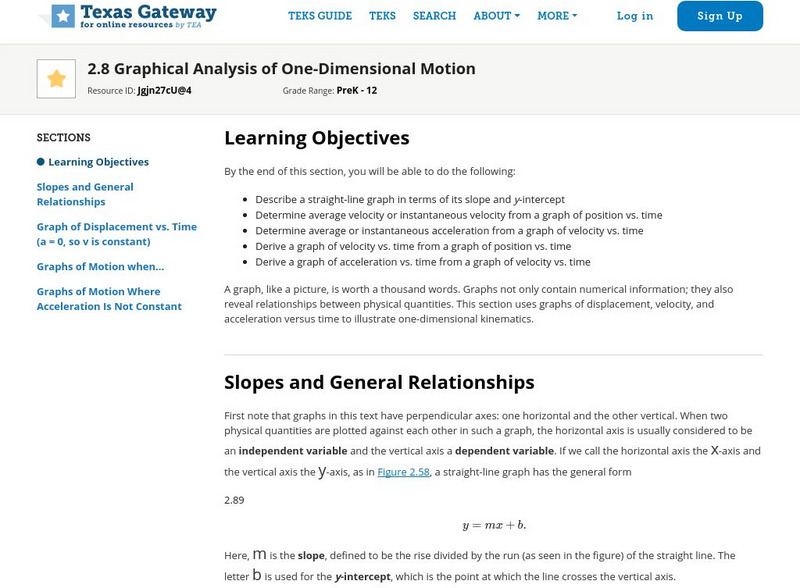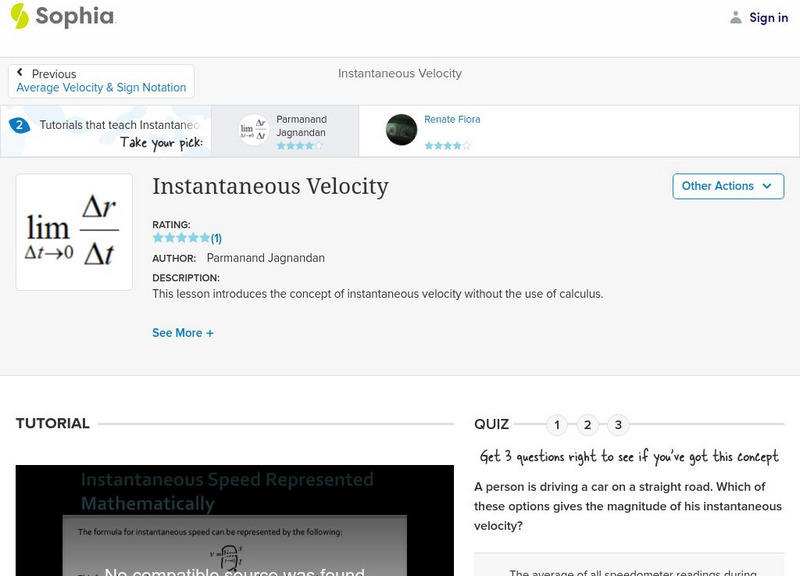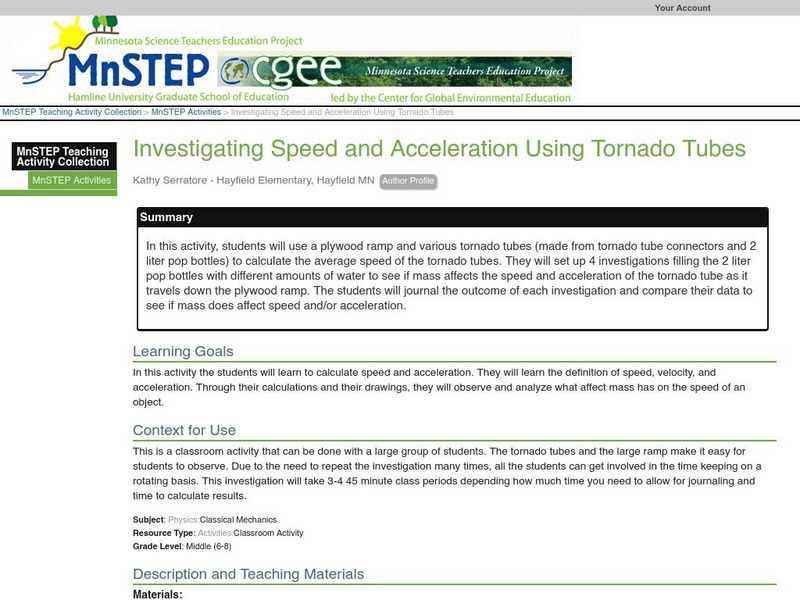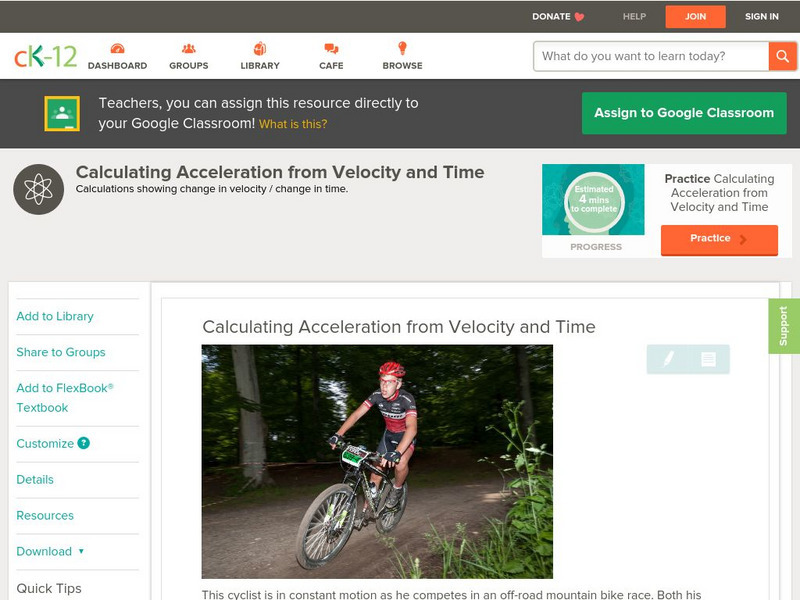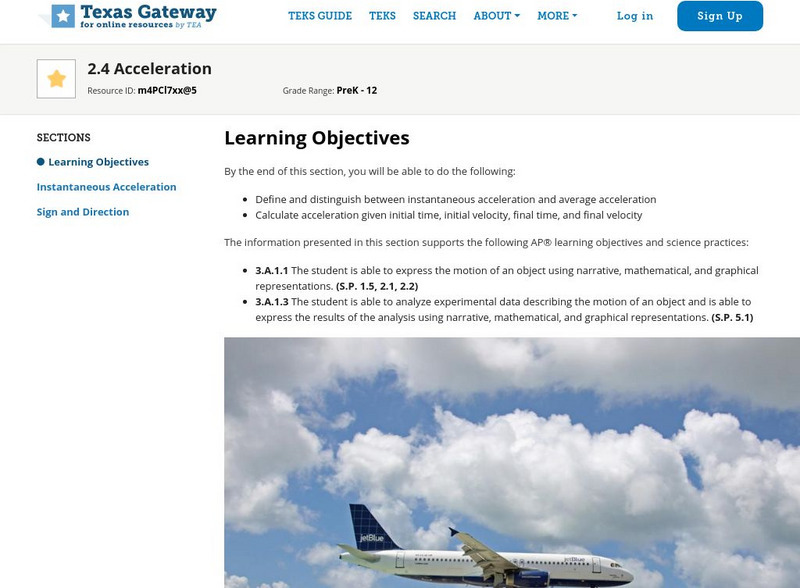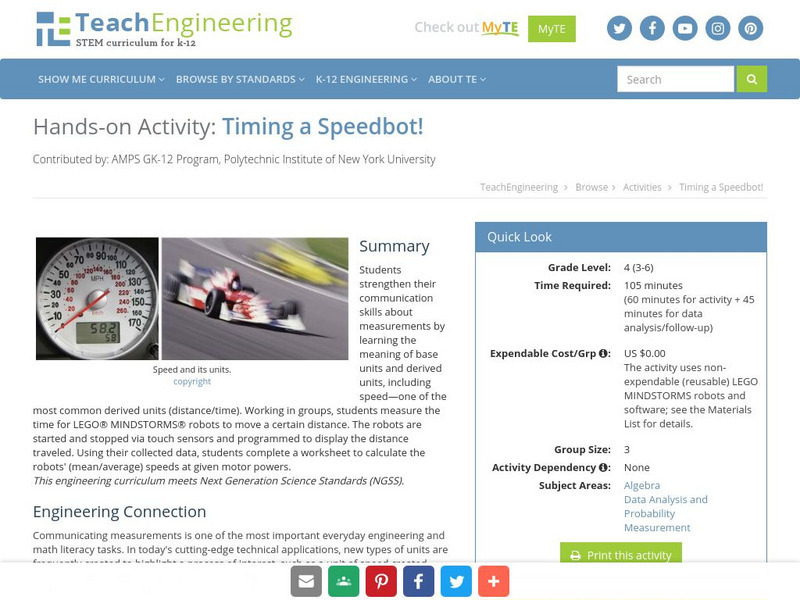Texas Education Agency
Texas Gateway: Kinematics: Graphical Analysis of One Dimensional Motion
By the end of this section, you will be able to describe a straight-line graph in terms of its slope and y-intercept, determine average velocity or instantaneous velocity from a graph of position vs. time, determine average or...
Science Education Resource Center at Carleton College
Serc: Balloon Rockets in 1 D
For this inquiry activity, students solve a 1D motion challenge in groups. Students build their own balloon rocket from the materials provided with little guidance from the instructor. They collect data and use it to prepare a position...
Science Education Resource Center at Carleton College
Serc: Egg Drop
In this physics lab, students build a container to safely deliver two eggs from the top of the school. Students calculate average velocity, acceleration, momentum, and the amount of force as it hits the ground. If their egg breaks, they...
Sophia Learning
Sophia: Instantaneous Velocity: Lesson 1
This lesson introduces the concept of instantaneous velocity without the use of calculus. It is 1 of 2 in the series titled "Instantaneous Velocity."
Texas Instruments
Texas Instruments: Graphing Motion: Instantaneous and Average Speed
Students are introduced to the calculator as a graphing tool and distinguish between average speed and instantaneous speed.
CK-12 Foundation
Ck 12: Physics Simulation: Dungeon Simulation
Experiment with changing velocity to help Tommy escape the dungeon.
OpenStax
Open Stax: Graphical Analysis of One Dimensional Motion
In the following interactive module students will describe a straight-line graph in terms of its slope and y-intercept. They will determine average velocity or instantaneous velocity from a graph of position vs. time.
Science Education Resource Center at Carleton College
Serc: Investigating Speed and Acceleration Using Tornado Tubes
In this activity, students will use a plywood ramp and various tornado tubes (made from tornado tube connectors and 2 liter pop bottles) to calculate the average speed of the tornado tubes. They will set up 4 investigations filling the 2...
Science Education Resource Center at Carleton College
Serc: Investigating Motion Graphing Speed
For this introduction to motion activity, students will get a personal understanding of speed and acceleration by experiencing it firsthand. Wheeled office chairs or other cart like devices are used to give one student a ride as a fellow...
Science Education Resource Center at Carleton College
Serc: Investigating Motion: Calculating and Graphing Students Walking Speed
In this activity students will collect and analyze data of their walking speed. They will compare their speed to an outside speed walker. They will determine their speed every 20 meters up to 100 meters. They will complete five trials to...
Science Education Resource Center at Carleton College
Serc: Investigating Speed and Velocity
In this investigation, middle schoolers will work in groups to design a model roller coaster, which will be used to clock the fastest speed for the rider (ball bearing/marble) The groups will build roller coaster models and modify and...
CK-12 Foundation
Ck 12: Physics: Motion Study Guide
This study guide on motion covers some key vocabulary and terms to describe motion: displacement vs. distance, acceleration, speed vs. velocity, and instantaneous vs. average. It includes graphs showing distance vs. time, velocity vs....
CK-12 Foundation
Ck 12: Phys. Science: Calculating Acceleration From Velocity and Time
[Free Registration/Login may be required to access all resource tools.] How to calculate average acceleration and the SI unit for acceleration.
Physics Classroom
The Physics Classroom: Average vs.instantaneous Speed
This is an animation illustrating the distinction between the average speed and the instantaneous speed for any given motion.
BBC
Bbc: Gcse Bitesize: Motion
This lesson focuses on motion including definitions, how to calculate the change in velocity and the average acceleration, and a link to an assessment.
Texas Education Agency
Texas Gateway: Ap Physics: 2.4 Acceleration
By the end of this section, you will be able to do the following: Define and distinguish between instantaneous acceleration and average acceleration; and Calculate acceleration given initial time, initial velocity, final time, and final...
Other
Easyphysics: Chapter 3 Acceleration
Learners investigate acceleration. Some topics examined are average acceleration, instantaneous acceleration, and velocity. The resource includes example problems with solutions and a chapter quiz.
CK-12 Foundation
Ck 12: Plix Series: Uniform Acceleration
[Free Registration/Login Required] Using the average acceleration formula, calculate the velocity of a falling ball, and then check your answer by dragging the point along the line in the given graph. After the activity, answer one...
TeachEngineering
Teach Engineering: Measuring G
Using the LEGO MINDSTORMS NXT kit, students construct experiments to measure the time it takes a free falling body to travel a specified distance. Students use the touch sensor, rotational sensor, and the NXT brick to measure the time of...
Northeast Parallel Architectures Center, Syracuse University
Northeast Parallel Architectures Center: Velocity
A quick overview, from Northeast Parallel Architectures Center, Syracuse University, about velocity, both average and instantaneous.
Texas Education Agency
Texas Gateway: Linear Momentum and Collisions: Impulse
By the end of this section, you will be able to define impulse; describe effects of impulses in everyday life; determine the average effective force using graphical representation; and calculate average force and impulse given mass,...
Science Education Resource Center at Carleton College
Serc: Student Analysis: Determine the Acceleration of a Toy Car
For this activity, students measure the displacement and elapsed time of a moving toy car using a direct measurement video with an embedded frame counter. They then calculate average and final velocity, and the average acceleration, and...
OpenStax
Open Stax: Physics: Acceleration
In this interactive module, students will define and distinguish between instantaneous acceleration, average acceleration, and deceleration. They will also calculate acceleration given initial time, initial velocity, final time, and...
TeachEngineering
Teach Engineering: Timing a Speedbot!
Students strengthen their communication skills by first learning the meaning of base units and derived units. Then, working in groups, students measure the time for LEGO MINDSTORMS NXT robots and calculate the robots' average speeds at...


